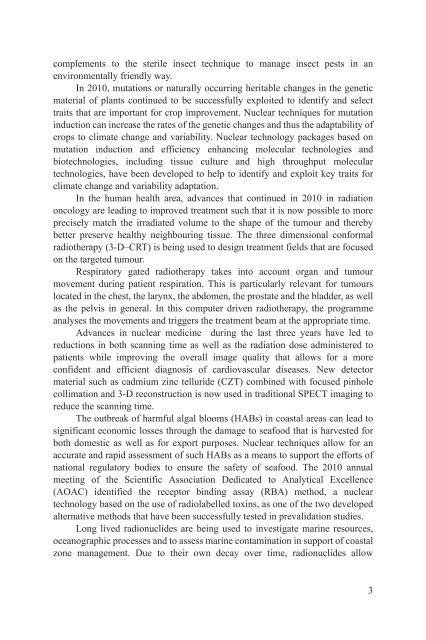Nuclear Technology Review 2011 - IAEA
Nuclear Technology Review 2011 - IAEA
Nuclear Technology Review 2011 - IAEA
Create successful ePaper yourself
Turn your PDF publications into a flip-book with our unique Google optimized e-Paper software.
complements to the sterile insect technique to manage insect pests in an<br />
environmentally friendly way.<br />
In 2010, mutations or naturally occurring heritable changes in the genetic<br />
material of plants continued to be successfully exploited to identify and select<br />
traits that are important for crop improvement. <strong>Nuclear</strong> techniques for mutation<br />
induction can increase the rates of the genetic changes and thus the adaptability of<br />
crops to climate change and variability. <strong>Nuclear</strong> technology packages based on<br />
mutation induction and efficiency enhancing molecular technologies and<br />
biotechnologies, including tissue culture and high throughput molecular<br />
technologies, have been developed to help to identify and exploit key traits for<br />
climate change and variability adaptation.<br />
In the human health area, advances that continued in 2010 in radiation<br />
oncology are leading to improved treatment such that it is now possible to more<br />
precisely match the irradiated volume to the shape of the tumour and thereby<br />
better preserve healthy neighbouring tissue. The three dimensional conformal<br />
radiotherapy (3-D–CRT) is being used to design treatment fields that are focused<br />
on the targeted tumour.<br />
Respiratory gated radiotherapy takes into account organ and tumour<br />
movement during patient respiration. This is particularly relevant for tumours<br />
located in the chest, the larynx, the abdomen, the prostate and the bladder, as well<br />
as the pelvis in general. In this computer driven radiotherapy, the programme<br />
analyses the movements and triggers the treatment beam at the appropriate time.<br />
Advances in nuclear medicine during the last three years have led to<br />
reductions in both scanning time as well as the radiation dose administered to<br />
patients while improving the overall image quality that allows for a more<br />
confident and efficient diagnosis of cardiovascular diseases. New detector<br />
material such as cadmium zinc telluride (CZT) combined with focused pinhole<br />
collimation and 3-D reconstruction is now used in traditional SPECT imaging to<br />
reduce the scanning time.<br />
The outbreak of harmful algal blooms (HABs) in coastal areas can lead to<br />
significant economic losses through the damage to seafood that is harvested for<br />
both domestic as well as for export purposes. <strong>Nuclear</strong> techniques allow for an<br />
accurate and rapid assessment of such HABs as a means to support the efforts of<br />
national regulatory bodies to ensure the safety of seafood. The 2010 annual<br />
meeting of the Scientific Association Dedicated to Analytical Excellence<br />
(AOAC) identified the receptor binding assay (RBA) method, a nuclear<br />
technology based on the use of radiolabelled toxins, as one of the two developed<br />
alternative methods that have been successfully tested in prevalidation studies.<br />
Long lived radionuclides are being used to investigate marine resources,<br />
oceanographic processes and to assess marine contamination in support of coastal<br />
zone management. Due to their own decay over time, radionuclides allow<br />
3

















